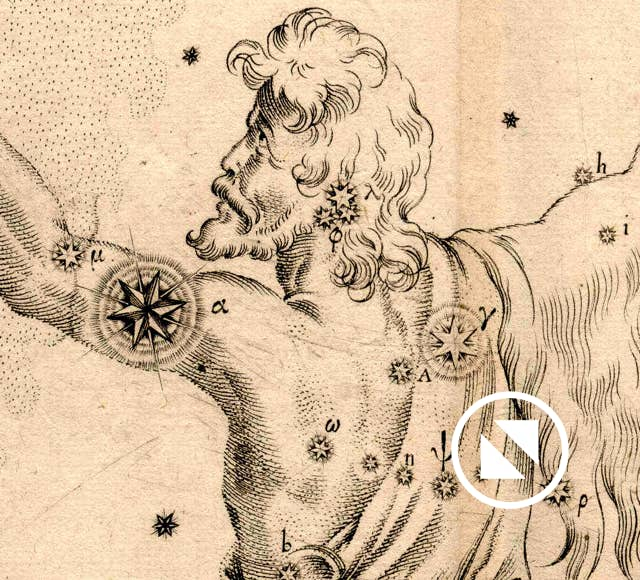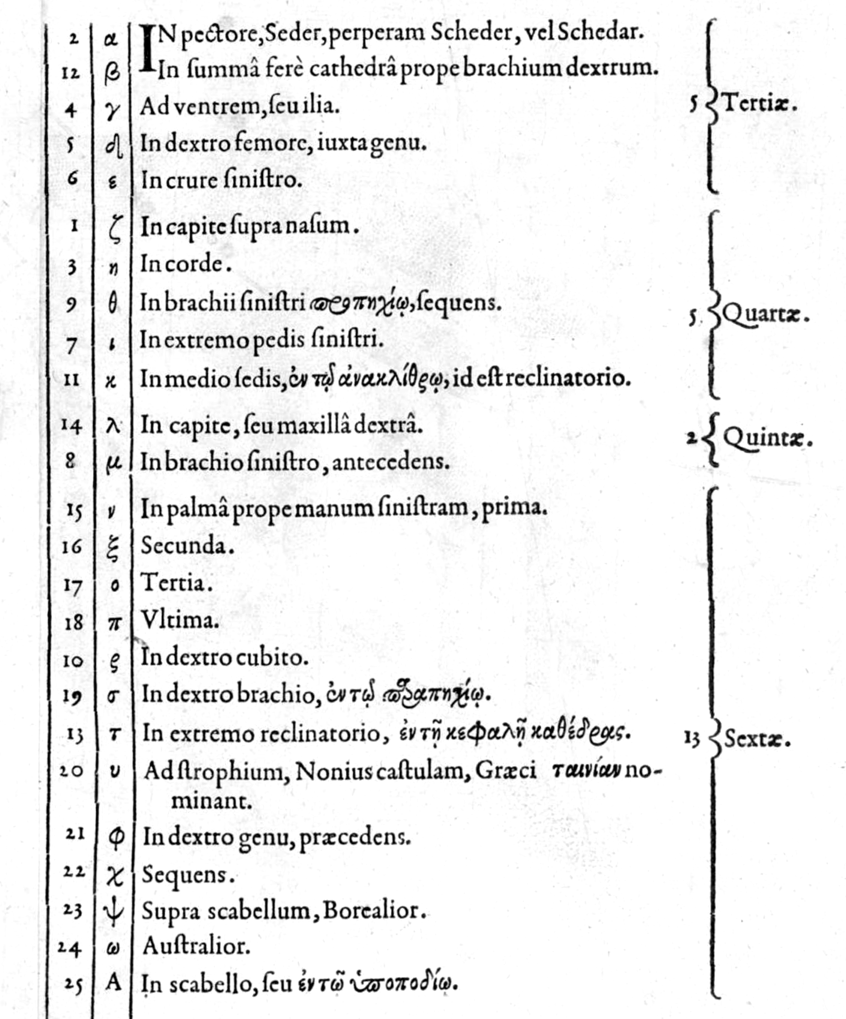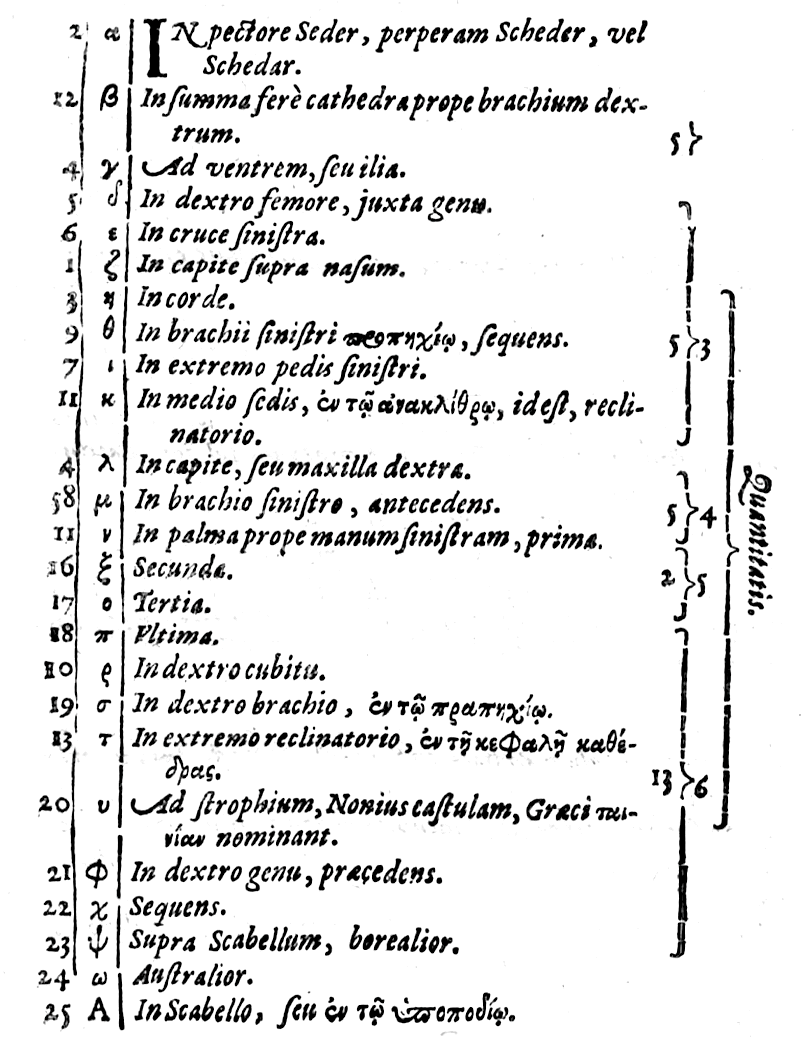Bayer’s Uranometria and Bayer letters
Johann Bayer’s Uranometria, published in 1603 at Augsburg, Germany, was the first major printed star atlas and one of the most influential celestial atlases in history. It contained plates for each of the 48 Ptolemaic constellations, plus one plate for the 12 new southern constellations that had been invented only a few years earlier from observations made on the first Dutch trading expedition to the East Indies. This was the first appearance of these southern constellations in an atlas. So popular was Uranometria that it was reprinted eight times between 1624 and 1689.
Bayer’s main source of star positions and magnitudes for the Ptolemaic constellations was Tycho Brahe’s catalogue of 777 stars published in 1602, augmented by the catalogue in the Almagest and observations of his own. In the first edition of the Uranometria, a table of stars in each constellation was printed on the reverse of each plate. It was in these lists that the famous Greek and Roman letters identifying the brightest stars made their appearance. They are now known as Bayer letters. (In fact, the idea of lettering the stars was not entirely original, for the Italian astronomer Alessandro Piccolomini (1508–79) had introduced the same idea in 1540 on the star charts in his book De le stelle fisse, using Roman letters rather than Greek ones. But Bayer’s authority was greater, as was the quality of his atlas, and it was his system that prevailed.)
Bayer did not allocate letters to any non-Ptolemaic constellations; that was done by later astronomers, notably Francis Baily in his British Association Catalogue of 1845 for the northern constellations, and both Nicolas Louis de Lacaille (Coelum Australe Stelliferum, 1763) and Benjamin Gould (Uranometria Argentina, 1877) for the southern ones.
Lettering the stars – a question of order
Contrary to popular belief Bayer did not letter the stars in strict order of brightness – in fact, magnitude estimates at that time were not good enough for this to have been possible. What he actually did was to group the stars by magnitude class, from first to sixth, then allocated letters to the members of each class as he saw fit. This differed from constellation to constellation.
Greek letters in the head and shoulders of Orion, from Bayer’s Uranometria (detail). Betelgeuse, at left, has been assigned the letter alpha, even though it is not the brightest star in the constellation (Rigel has that honour), while Bellatrix is labelled gamma.
For example, in Ursa Major the seven stars of the Plough were labelled in order of right ascension. In Gemini, the three brightest stars were labelled by declination, from north to south; while in Cygnus the sequence of letters for the brightest stars follows the overall shape of the constellation. In many other constellations, and particularly among the fainter stars, there is no obvious pattern to the distribution of letters at all.
As a result of this somewhat haphazard process there are actually 16 constellations in Bayer’s catalogue in which the star labelled Alpha is not the brightest: Cancer, Capricornus, Cetus, Corvus, Crater, Delphinus, Draco, Gemini, Hercules, Libra, Orion, Pegasus, Pisces, Sagitta, Sagittarius, and Triangulum.
In the larger constellations, once the 24 Greek letters from alpha to omega were exhausted Bayer turned to Roman letters, starting with a capital A followed by lowercase b, c, d, etc. Hercules, with 48 stars, was the only constellation in which he reached z. (The letters j and v were omitted, but o was included.) Not all the stars plotted on the charts were listed in Bayer’s catalogue, so numerous faint stars on the charts remained anonymous.
Duplicate stars
Bayer’s catalogue contains a total of 1,164 Greek and Roman letter designations, but five of those are duplicates. In three cases the stars concerned were regarded by Ptolemy as being shared between constellations: Alpha Andromedae (the head of Andromeda) was regarded by Ptolemy as also being part of Pegasus, so Bayer gave it the alternative designation Delta Pegasi; Bayer’s Beta Tauri (the tip of the bull’s horn) was the same star as his Gamma Aurigae; while his Nu Boötis was the same as his Psi Herculis.
These dual identities were retained by astronomers for over 300 years, until the revision of the constellations by the IAU in 1930. Alpha Andromedae, Beta Tauri, and Nu Boötis emerged from this reorganization with their identities intact, but there is now no Delta Pegasi, Gamma Aurigae, or Psi Herculis. In addition to those three, the American historian Morton Wagman notes in his exhaustively researched book on Lost Stars that Bayer also duplicated Xi Arietis/Psi Ceti and Kappa Ceti/g Tauri by mistake. Nowadays there is no Psi Ceti or g Tauri.
Confusing the statistics further, some of Bayer’s designations were meant to apply to more than one star. For example, in Capricornus the Greek letter alpha was applied to both members of a naked-eye double (Bayer recognized it as double, describing it as ‘duplex’, whereas Ptolemy had not), while in Orion the letter pi (π) applied to all six stars in the arc forming the lion’s pelt or shield on his left arm. In such cases, later astronomers added superscripts to Bayer’s letters (π1, π2, π3, etc.) to distinguish the individual stars.
Missing stars
As well as assigning Greek and Roman letters to each of the stars in his catalogue, Bayer also numbered them in the left-hand column. These identification numbers apparently came from a preliminary working list compiled by Bayer. Over 100 stars on this preliminary list were omitted from the printed catalogue, which we can tell because the corresponding numbers are missing. Possibly Bayer dropped these stars from the final version because he was dissatisfied with the accuracy of their measured positions. This raises an inconsistency in the catalogue, because the totals for each magnitude class printed at the right of the page refer to Bayer’s preliminary list and not the redacted version as actually printed. Here are the identification numbers omitted from the printed catalogue, by constellation:
Cygnus: 15, 18, 27, 28, 33 (five stars).
Auriga: 23–31 (nine stars).
Serpens: 19–25, 32 (eight stars)
Taurus: 30, 31, 34 (three stars).
Cancer: 17, 19, 20, 23, 25, 30, 34 (seven stars).
Leo: 39, 40, 41, 42 (four stars).
Virgo: 32, 36 (two stars).
Scorpius: 11, 16 (two stars).
Capricornus: 27, 28 (two stars).
Aquarius: 29, 30, 31, 34, 36, 37, 39, 40 (eight stars).
Pisces: 29, 30 (two stars).
Cetus: 5, 17, 18, 19 (four stars).
Orion: 9, 11, 14, 17, 20–24, 41 (ten stars).
Eridanus: 8, 18–25, 27–32 (fifteen stars).
Canis Major: 6, 7, 10, 12 (four stars).
Canis Minor: 4 (one star).
Argo: 15, 18, 20, 22, 23, 27, 28, 29, 42, 43, 48, 50–55, 58–61 (twenty one stars).
Hydra: 8, 14, 28 (three stars).
In total: 110 stars omitted.
The Explicatio, a flawed star catalogue
There were two disadvantages of printing the catalogue on the back of the charts in Uranometria: it was impossible to read the star list while looking at the chart, and the lettering showed through the page and spoiled the chart, as can be seen here.
The solution was to print the catalogue separately. Reset in a smaller format, it appeared under the title Explicatio characterum aeneis Uranometrias in 1624, the year before Bayer’s death, and was republished in 1640, 1654, 1697, and 1723. Unfortunately, this separate catalogue was marred from the start by typographical errors, which were compounded when the type was reset for each new edition. (The 1723 reprint reused the standing type from the 1697 edition so their catalogue pages are identical.)
Bayer’s catalogue –
stars of Cassiopeia in the Uranometria (left) and the Explicatio (right)
As an example, look at the page for Cassiopeia in the illustration above. On the left is the original table from the Uranometria, while on the right is the version from the 1697 edition of the Explicatio. In the Explicatio the curly brackets at the right of the star list, which were intended to group the stars in each magnitude class, were reversed by comparison with those in the Uranometria. In many cases the new brackets are incomplete or have slipped with respect to the listed stars. Evidently the printers either failed to recognize the purpose of these brackets or were simply careless.
Worse are errors in the numbering and lettering of stars. In the examples above, compare the numbers in the left-hand column for the stars lambda, mu, and nu. In the original catalogue, these are numbered 14, 8, and 15. By the time of the 1697 Explicatio, these numbers had been scrambled to become 4, 58, and 11. There are many more such typographical errors lurking in the numbers columns on other pages which would have severely confused the unwary user.
I have not found any cases in the Explicatio where the Greek letters are wrong, but in the 1697 edition a Greek letter has vanished both in the listings for Draco and Aquarius, while in Hercules the letter A is printed in lowercase rather than uppercase, and in Orion the letter n is upside down. This catalogue was in need of a decent proof reader.
© Ian Ridpath. All rights reserved


